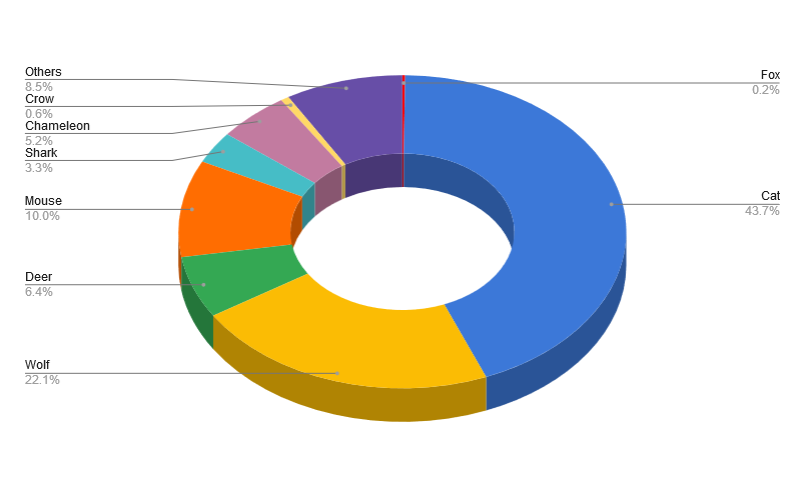Spirits
Spirits are a unique species alongside humans, visually distinguished primarily by their animalistic or otherwise unusual features. These can manifest as features from nearly any type of animal - or in rare cases, even many types of plant - on Earth, but are typically limited to minor additions or changes to the otherwise humanlike body. They share the same cultures and ethnicities as humans do, although some groups of spirits additionally have their own subcultures, which can be either consistent worldwide or regional. They are also notable for having a strong affinity with mystic matter, even among individuals that possess neither alignment nor attunement.
While spirits appear remarkably similar to humans, even to the point of being effectively identical in most anatomical aspects, they are still a distinctly different species: H. varius. Additionally, each of the many varieties of spirit is also classified with at least one subspecies. For example, the trinomial H. varius catus, or the polynomial H. varius lupus albus.
Despite there likely being a type of spirit for virtually every animal, and even some varieties of plant, only eight types of spirit are of particular prominence. These eight varieties of spirit are significantly different from humans and each other, and are referred to as “major spirits”.
All other varieties of spirit are referred to as “minor spirits” and are typically much less distinct from humans, even sometimes being hard to distinguish at all from humans or each other, while also making up only a combined ~8.5% of all spirits. However, very rare examples may be so extremely different from humans and even major spirits spirits that they can appear almost alien, but are still considered minor due to being extremely few in number.
History¶
Spirits have existed on Earth since Era Dira, as confirmed by the existence of various artifacts dated at over 3000 years old, but there is yet to be a consensus on just how old they are, or their origins.
Throughout the history of the world, spirits have been subject to extreme prejudice. Many believe that this was rooted in fear, but there is little consensus on why it persisted for so long.
Spirits have been victims of multiple genocides, countless hate crimes, and extremely unfair treatment throughout history, and have never had the chance to recover, causing spirits to become an incredibly small minority of all people. To give an idea of just how much they have lost, it is thought that during Era Dira, spirits actually outnumbered humans two to one.
Only in modern times has this extreme prejudice begun to wane as much of human society changes to be more accepting of spirits, though they still struggle. Spirits are often treated with cautious fascination today.
Anatomy & physiology¶
Most commonly, spirits possess the ears (or another head feature like antlers, antennae, fins, etc.) of their related animal, and a tail. For those with animal ears, some spirits may have only their animal ears, while others may have both animal and human ears. The eight types of major spirits also all possess major sensory changes similar to their related animals, while minor spirits typically do not.
Spirits seem to be almost entirely unaffected by human allergies to anything natural, but are much more sensitive to synthetic substances on average, particularly in food and drugs. However, many spirits do often inherit some of the same substance sensitivities as their related animals. These sensitivities can vary in severity on an individual basis, but are not lethal, even if it would be lethal to the related animal. Spirits are often instinctually aware of these sensitivities. For instance, wolf spirits are repulsed by grapes and onions, and cat spirits are attracted to catnip.
Caffeine is lethal to all spirits in high enough dosages. A single average cup of coffee can give any spirit noticeable heart palpitations, and can be dangerous for small or unhealthy spirits. Tea, however, is much safer for spirits and rarely causes any side effects, provided they only drink one to four cups per day, depending on the caffeine content of the brew and the body mass of the spirit. Most spirits can detect caffeine content through smell or taste even in trace amounts.
Genetics and Reproduction¶
Spirit genealogy and reproduction works the same way as it does for humans and they remain genetically compatible as a result. However, their genetic strength is weak against that of humans, leading most human/spirit offspring to be human, and only a small portion to be spirit.
Two different types of spirit can also reproduce, but the resulting offspring will carry the physical traits of just one parent, and only very rarely inherit non-physical traits from both parents. Hybrids are almost entirely unviable between spirits, and the dominant genes in the offspring appear to be entirely random. Research has yet to ascertain the cause of this.
Distribution¶
Spirits are found all over the world, with certain types preferring certain climates and landscapes. Today, spirits make up approximately 5% of the world population, with major spirits making up approximately 91.5% of all spirits, and minor spirits only 8.5%.
Major spirits:
Minor spirits:
- N/A for now
